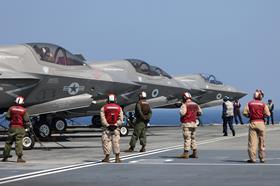Lawmakers in Washington are becoming increasingly agitated about the lack of new Lockheed Martin F-35 fighters being delivered to the US military.
Specifically, members of Congress are frustrated with the inability of military airframer Lockheed to complete airworthiness certification on the latest technical configuration of the advanced stealth fighter, known as Technical Refresh-3 (TR-3).
Ongoing difficulties with certificating the TR-3 package, which includes improved avionics and new operating software, compelled the Pentagon to stop accepting most new deliveries of the F-35 in July 2023.
TR-3 is intended to radically improve the F-35’s already-powerful suite of onboard communications and data processing systems, turning each jet into a battlefield node for collecting and distributing information during combat, according to the Pentagon.
Washington continued to accept a small number of older TR-2-configured jets, but the issues substantially reduced Lockheed’s F-35 delivery figures last year. The airframer turned over just 98 F-35s in 2023, despite an annual production capacity of 156 jets.
Lockheed has been struggling for over a year to achieve airworthiness certification on the TR-3-configured F-35 design, which began flight testing in January 2023. Chief executive James Taiclet described the process as being in the “very late innings” one year ago during an April 2023 earnings call.
The company has repeatedly pushed back its projection for completing TR-3 certification, with the latest estimate being sometime in the third quarter of 2024.

Fed up with the delays, elected officials in Washington are openly expressing frustration with Lockheed, and to a lesser extent the Pentagon, for attempting to push the technology into service before it was ready.
Congressman Rob Wittman, who chairs the armed services subcommittee on tactical air and land forces, described his dissatisfaction with the TR-3 situation – and Lockheed’s handling of it – during a 16 April hearing on fixed-wing aircraft procurement.
“It was bitterly disappointing to myself and other committee members that we had to learn about another shift to the right to Q3, not directly from the contractor, but from an earnings call that we had to read in the newspaper,” the Virginia Republican noted, referencing comments Taiclet made in January during Lockheed’s 2023 year-end earnings announcement.
Wittman went on to describe “lots of shortcomings with how TR-3 has been tested and developed”.

That sentiment is apparently shared by members of the opposition Democratic party, including the subcommittee’s ranking member Donald Norcross of New Jersey.
“Going back year after year, talking about this and each time we’re kicking the can down the road,” Norcross said in the hearing. “It’s always something new.”
Norcross went on to ask the Pentagon’s top officer for F-35 procurement, Lieutenant General Michael Schmidt, how many completed F-35s are in Lockheed’s possession awaiting delivery.
Schmidt declined to provide a specific figure, citing security concerns, but confirmed it is “a significant number” of aircraft.
Lockheed declined to answer any questions on the matter, citing the so-called quiet period required under US securities laws ahead of financial filings. The company is scheduled to deliver its first quarter earnings on 23 April.
It has previously said it is continuing to assemble F-35s at its full target rate of 156 aircraft annually. An average of 13 jets per month, combined with a delivery stoppage date of August 2023, would put more than 100 jets as being held in storage.
When asked for his assessment of delays, Schmidt said the Pentagon is exploring options for a “truncated” version of TR-3 that could be ready this summer.
“The first realistic chance is July,” the three-star general said, noting the F-35 Joint Program Office’s (JPO’s) internal software review team estimates a more likely timeframe of August or September.
“I’m as frustrated as you that I can’t nail down a specific date and be extremely clear about exactly when we will deliver,” Schmidt added.
It is unclear what a truncated version of TR-3 would look like. Schmidt says such an approach would likely use the F-35’s existing operating software, perhaps with some “little tweaks” for more modest capability improvement.
The acknowledgement represents a major setback to the Pentagon’s long-term plan for the fifth-generation fighter, which includes new sensor suites, more long-range precision weapons, improved electronic warfare features and more powerful data fusion in the forthcoming Block 4 design of the F-35.
Those upgrades are dependent upon the improved computing power delivered by the TR-3 package, which now appears to be at risk.

Schmidt says the real cause of delays to TR-3 certification is an attempt to address “hardware immaturity” with “a lot of software workarounds” – a condition driven in large part by the Pentagon’s push to rapidly add new capabilities to the F-35.
“That’s not a long-term winning solution,” he adds.
In response to problems with both hardware and software, Schmidt says the JPO intends to “re-imagine Block 4” with a set of capabilities that are ready for employment, rather than attempting to develop them concurrently with active production.
He bluntly describes such concurrent development programmes as “pipe dreams” that undercut “engineering rigour”.
“We’ve already made poor choices,” Schmidt acknowledges, vowing a new approach. “But I need some help from industry,” he told lawmakers.
Despite years of delays and costly technical issues, both the Pentagon and Congress appear committed to the F-35 programme, which has become a centrepiece of US war planning.
“We are all in on this aircraft,” Wittman says.
The Pentagon plans to acquire a staggering 2,456 F-35s across the US Air Force, US Navy and US Marine Corps, covering all three variants of the stealth fighter.
Lockheed completed assembly of the 1,000th F-35 in January.































